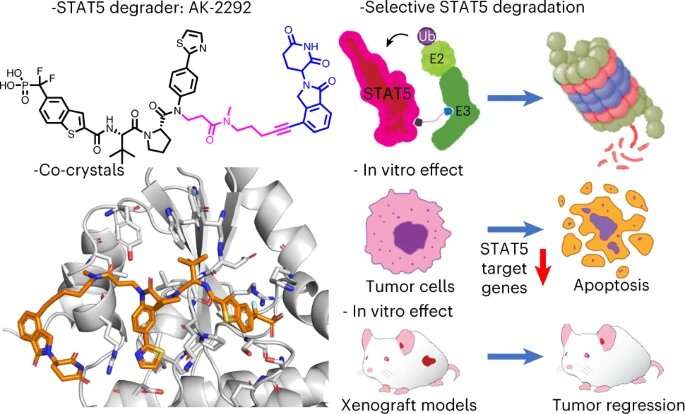This article has been reviewed according to Science X's editorial process and policies. Editors have highlighted the following attributes while ensuring the content's credibility:
fact-checked
peer-reviewed publication
trusted source
proofread
Researchers use a new approach to hit an 'undruggable' target

The protein STAT5 has long been an appealing target against cancer, but after decades of research it was consigned to the "undruggable" category. Now, University of Michigan Rogel Cancer Center researchers have found success with a new approach.
By tapping into a cellular garbage disposal function, researchers found they could eliminate STAT5 from cell cultures and mice, setting the stage for potential development as a cancer treatment.
STAT5 plays a key role in how some blood cancers develop and progress. But efforts to identify a small molecule inhibitor to block STAT5 have been stymied. Previous research efforts have found it challenging to design a drug to bind to STAT5 with a high-affinity, a measure of how well they fit together. Even when a compound was found to bind with the protein, it may not make its way into cell and tissue. It's also difficult to find a compound that inhibits STAT5 only without affecting any of the other STAT proteins.
Shaomeng Wang, Ph.D., Warner-Lambert/Parke-Davis Professor in Medicine and professor of medicine, pharmacology and medicinal chemistry at the University of Michigan, had another idea.
His lab has been working on a new drug development approach targeting protein degradation. This is a naturally occurring function within cells to get rid of unwanted protein. Think of it as the garbage disposal: When a protein is no longer needed to keep a body healthy, this mechanism removes the unwanted or damaged protein from the cell.
Using this approach, Wang's lab identified a protein degrader, AK-2292, that targets and removes STAT5. The compound was highly specific to STAT5 with no effect on other STAT proteins. It was effectively taken up by both cell lines and mouse models and was found to stop cell growth in cell lines of human chronic myeloid leukemia (CML) and to induce tumor regression in mouse models of CML. Results are published in Nature Chemical Biology.
The protein degrader works by eliminating STAT5 proteins from tumor cells and tissues, unlike a small molecule inhibitor that would traditionally be designed to bind with the protein and interfere with its function.
"We've overcome some of the major issues that were barriers for scientists to target STAT5," Wang said. "People have worked in this field for the last 20 years, and there are no small molecules targeting STAT5 going into clinical development. This study shows us STAT5 can be targeted through a protein degradation approach. It's a new, exciting direction for developing a potential drug molecule targeting STAT5 for the treatment of cancers in which this protein plays a major role."
"This compound gives us a very solid foundation to do further optimization to identify a compound that we eventually can advance into clinical development," Wang added.
Wang's lab has been investigating protein degraders for several years and has a number of degraders in advanced preclinical development studies, which they hope will lead to clinical trials for the treatment of cancer in people.
More information: Atsunori Kaneshige et al, A selective small-molecule STAT5 PROTAC degrader capable of achieving tumor regression in vivo, Nature Chemical Biology (2023). DOI: 10.1038/s41589-022-01248-4



















